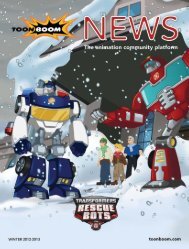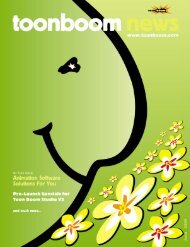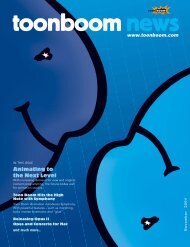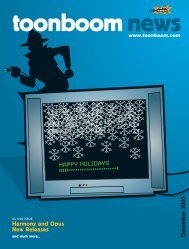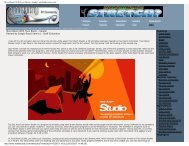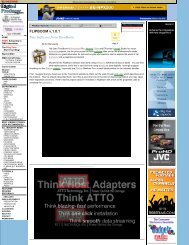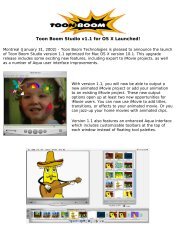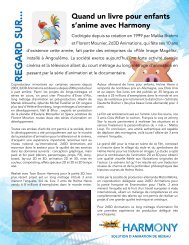December - Toon Boom Animation
December - Toon Boom Animation
December - Toon Boom Animation
Create successful ePaper yourself
Turn your PDF publications into a flip-book with our unique Google optimized e-Paper software.
case studyImage courtesy of tMike TracyReal world tools Mike Tracy has taught at the Art Institute of California - Orange County for sixyears. Prior to that, he worked as a layout artist in both feature animation and TV. He began his animation careerat Walt Disney Features working as a layout artist on Fantasia 2000 and went on to work on Emperor's NewGroove, and did layout on additional footage for Beauty and the Beast. He worked on several TV productions asa freelancer, doing layout, workbook and lighting guides for shows at Sony, DIC and Film Roman. He did layoutand development work at Warner Brothers for the films Iron Giant and Osmosis Jones.Image courtesy of tMike TracyHe is also a painter whose work is included in numerous corporateand private collections, as well as often appearing onthe sets of feature films and television series. Some of theseinclusions include feature films from Paramount, Castle Rock,Disney and Fox. His work has appeared on the sets of weeklyseries such as I'm With Her, My Wife and Kids, Six FeetUnder and Four Kings as well as others.The Art Institute is a private, for-profit post secondaryinstitution with 29 schools throughout North America. The ArtInstitutes have provided career-oriented education programsin design, media arts, fashion and culinary for over 35 years,and has more than 125,000 alumni. They provide bachelor’sand associate’s degrees in Culinary Arts, Game Art & Design,Graphic and Industrial Design, Interior Design, Media Arts &<strong>Animation</strong> and Multimedia & Web Design. In the Media Artsand <strong>Animation</strong> program, students begin with a substantialfoundation in drawing, color, design, video production, andcomputer applications. From this foundation, students developadvanced skills in various aspects of computer graphicsand animation. Students learn to use the tools of the computeranimation profession, ranging from computer operatingsystems to 3D modeling and desktop video production.These tools enhance students’ flexibility and creativity, andenable them to produce an individualized digital portfoliothat demonstrates their practical and technical abilities topotential employers.As a part of the Media Arts and <strong>Animation</strong> curriculum,students take a class in ink and paint that utilizes <strong>Toon</strong> <strong>Boom</strong>Studio. This class focuses on animation, background and layout,scene planning, compositing and story-telling. MikeTracy has taught a section of the class for more than threeyears and draws on his feature animation experience to producea series of exercises that help the students acquire bothconceptual understandings of each of the important activitiesin a typical production environment as well as exploring theuse of this technology in pursuit of story-telling.During the eleven–week Digital Ink and Paint course,students are introduced to the technical production processesof putting animation together.The lessons explain theprocedure of importing handgeneratedart, converting drawnanimation into cleaned-up,vector-based art and paintingit. The class will also explorethe nature of scene-planning,which is the process of compositingvectored animationwith raster-based painting elements,and creating the camera moves, including a pan,repeat pan, truck in and out, and multiplane required to tella story. Students primarily use <strong>Toon</strong> <strong>Boom</strong> Studio as the platformfor this work, in combination with other applications.“The difference with <strong>Toon</strong> <strong>Boom</strong> Studio, however, is that ituses a very similar interface design to the ones used in mainstreamanimation production”, shares Mike. The elementsare assembled in an X-sheet format, then composited in acamera window using pegbar elements to execute the sceneplanning activities. “<strong>Toon</strong> <strong>Boom</strong> Studio is an excellent alternativefor small, quickly executed films, in a sense, you couldconsider the application as a moving ‘sketch-book’ for youranimation ideas. For this reason, we will execute everythingin <strong>Toon</strong> <strong>Boom</strong> Studio this quarter”.In addition to their skills evaluation, the grading system isbased on the students’ understanding and proficiency inusing the <strong>Toon</strong> <strong>Boom</strong> interface, creating small, full-color filmclips utilizing cuts, trucks, pans and multi-plane camera movesas well as their overall quality, complexity and thoroughnessof their work. The final project is a one to two-minute animatedfilm, complete with sound and dialog that shows theirability to produce cleaned-up, vectored animation with rasterizedbackground elements in a series of camera moves.“<strong>Toon</strong> <strong>Boom</strong> Studio is an ideal platform for the needs ofour students because it utilizes real world tools such as thex-sheet and peg assemblies while maintaining a fairly easylearning curve. Most students get results right away.”toonboom news DECEMBER 2006 7
case studyImage courtesy of NelvanaMaking Ruby Gloom in Harmony Darin Bristow has worked at Nelvana for over 12 yearsserving in a variety of 2D and 3D capacities. His 2D skills can be seen on such series as Eek! The Cat, Samand Max: Freelance Police, and his 3D skills on such projects as Rescue Heroes: The Movie, Miss Spider, andHandy Manny. Darin is currently Ruby Gloom’s Supervising Technical Director and offered us these observations.“I did it. I came back to 2D from 3D, and my timing couldn’thave been better! The advances in <strong>Toon</strong> <strong>Boom</strong>’s latestanimation system were the key. Whenever a work meetingwould take me for a wander through the Nelvana 2Ddepartment, I would always look over the shoulders of fellowemployees to see what the current state of the mediumwas and ask myself “do I miss that?” The first year theanswer was “not yet”. The technological advances in the3D realm had kept me intrigued. I felt the nostalgic pangof seeing people sketching and erasing away, but at thetime 3D felt right. It felt like the future. The second yearthe answer was still “not yet”, but something seemed onthe horizon. Something big. Fast-forward a few years (andseries) later, I was venturing through the 2D domain oneDarin Bristow is currentlyRuby Gloom’s SupervisingTechnical DirectorImage courtesy of Nelvanaday and saw then what we now call ‘Harmony’. When Istopped to see the endless possibilities it offered, onlyone word went through my mind- “Now”. Harmony’stechnology really offered the tools to effectively blur theline between the 2D and 3D realms”shares Darin.“Luis Lopez, a Senior Technical Producer at Nelvana,offered me the chance to learn Harmony for a new 2DDigital series called Ruby Gloom and act as its SupervisingTechnical Director. Luis was about to revamp and implementnew production pipeline procedures for our 2Ddigital department and he wanted me to be part of thatteam, so I snatched up the opportunity and haven’tlooked back. We knew that Harmony was a solid applicationready to handle any challenge we threw at it. In thislatest version, the software has taken a huge leap forwardin the level of visual story telling. Our most recent production,Ruby Gloom has implemented this technology, mixingit with the fundamentals of traditional animationmovement, and the results are fantastic. We are lookingfor a cartoon, with all the zip and snap found in the shortsof the forties and fifties. Harmony has been the key to thelook, movement, and overall feel of this production.”“By designing our show with Harmony’s strengths (andweaknesses) in mind, all the fluid stretch and squashfound in traditional animation is possible. A major factorto the successful movement is found in the timing. Forexample, violent, snappy movement is absolutely brilliantwith this system. Subtle anticipation before a major movement,along with a settle into a hold following that violentmove, disguises the stretch and distortion of the moveitself. We want to feel the fluidity more than see it.8 toonboom news DECEMBER 2006
Understanding these animation fundamentals of early“limited” animation from historic studios like UPA andHanna Barbara are crucial in harnessing the strengths ofHarmony. The characters are quite flat and 2D, but byusing the techniques of snappy animation coupled withthe 3D set, the limitations are virtually non-existent.”Image courtesy of NelvanaThe story ideas set by producer Merle Anne Ridley andstory editor Carolyn Hay required an animation approachthat allowed complete flexibility. Massive zoom-ins, zippans, or the more subtle movement such as slow movingclouds and atmospheres are no problem. With carefulattention to pre-production and of course the animationitself, strong character performance is very achievable.“We all knew from day 1 that this show was going tobe fresh, fun, and inventive. Combined with our WACOMCintiqs, Harmony offers the technological sum of everythingthat was great about traditional 2D animation of thepast, mixed in with all that is great about digital animationof the present, and then adds the heavy dose of thefuture. The result is something new and visually cuttingedge. No matter what the visual challenges demanded bythe director, Harmony would handle it. The visually poppingthe graphic, stylized art direction of the Ruby Gloomcharacters took us into the land of using highly detailedpainterly Photoshop Backgrounds Designs. Many of thesedigital bitmap paintings contained upwards of 10-15 layers,all at 150 dpi, making them quite large- but yet Harmonyhandled them with ease. So easy in fact, we soon foundthat we could increase our source BG resolutions up to300 dpi to maintain visual integrity in order to supportRuby Gloom’s high-definition composites, and zany zoomincamera moves.”The Ruby Gloom character designs also proved a 2Ddigital challenge themselves, Director Robin Budd wantedto maintain the ‘no-outline’ look of Ruby’s initial designs,yet have a percentage-colored line form only when twoidentical colors passed over one another, and have anoffset character ‘rim light’ throughout animation. Thefundament art direction mantra was ‘light against dark’for maximum character ‘pop’, but that became an issuewith some of the established dark costume against thedark backgrounds. “Using Harmony’s highly advancedNetworks and tools, we were able to avoid a potential animationnightmare by simply rigging all these featuresright into the character models, thus keeping it off the animators’shoulders, and production friendly. It allowed theanimation team to just work freely, and due to how werigged each character up front, the rim light would makeitself by offsetting the animators key frame’s and notworry about it.”The sheer creative freedom Harmony offers the RubyGloom team has helped create a very unique and visuallystunning product that has, and is, commanding the worldwideattention it deserves.Robin Budd has been passionately immersed in theanimation business for 29 years. The seventies and eightieswere focused on full, fluid traditional character animation oftelevision specials for Nelvana, and feature films both inToronto and Tokyo. In 1989, he directed his first televisionseries, Tim Burton's Beetlejuice, and won an Emmy for mostoutstanding series. Years of feature development followed,for both Nelvana and Paramount Pictures. He joined Disneystudios in the late nineties and directed the sequel PeterPan, Return to NeverLand. The focus then shifted to storyboardwork on a variety of television series, such as Samand Max, Clone High, Jacob Two-two, and 6Teen. His mostrecent work is development and direction of GeraldMcBoing Boing and Ruby Gloom.Image courtesy of Nelvanatoonboom news DECEMBER 2006 9
case studyTo the next level Based in Basel, Switzerland, Mayer Films was founded by Gilbert Mayer in2005 with the aim to produce independent feature films and animation for cinema, TV, DVD and Internet.Up to that date, Gilbert was mainly working in the field of commissioned work for the industry includingcommercials and image films, be it animation or documentary.Gilbert also produced his first feature film for a young audiencecalled Urban Odyssey. Another Mayer Films release isthe animated short Ralf the Rat: Toulouse Lautrat which wasshown at the national Festival of Swiss Films in Solothurn. Hislineup of projects is quite impressive and includes Rien ne vaplus, an animated series about an old peoples’ asylum, TheNew Kasper, a children’s series with hand puppets and 3Dbackgrounds, Bearytales, animated stories for children aboutthe nightly activities of Teddy bears, mobiletoonland.com,downloadable content for mobile phones and Origin (workingtitle), his next feature film. “<strong>Toon</strong> <strong>Boom</strong> Studio is my centralsoftware for the whole production, although I shall be usingSoftimage XSi, Photoshop and Vegas as an editing software.For Rien ne va plus, I'll be drawing all characters on paper andeven coloring them with Ecoline water-based liquid layout colors.This gives me a rich textured look with flickering colors,when characters are animated. I'm a bit of a traditionalist,being in this business 35 years.Of course I use <strong>Toon</strong> <strong>Boom</strong> Studio’s drawing tools foradditional bits and pieces, like blinking eyes, flying insects orwhatever small moving props are necessary. My hand-paintedcharacters are scanned in as images in this special project. I haveto consider the maximum resolution, as I work with pixels. Themaximum output of the film will be HDTV 1080p (1920x108016:9 ratio) and the minimum a PAL widescreen 16:9 resolution.I use the smaller resolution for editing and change the fileswhen ready for release. My backgrounds are sets done in a 3Dpackage. In <strong>Toon</strong> <strong>Boom</strong> Studio, I make cut-out puppets frommy scanned characters. I put the characters together in a hierarchy.Usually, they consist of body, head, upper arm, lowerarm, hand, upper leg, lower leg, foot, separate mouth shapesand eyes. I give all the elements a parent peg, put themtogether in a hierarchy and finally arrange them from foregroundto background. I switch then to the Pegbar OnlyMode for more convenient working with the pivot points.Normally with a cut-out character all movements are rotationsaround the pivot points. Sometimes, I let <strong>Toon</strong> <strong>Boom</strong>Studio calculate all the in-betweens from one key frame toanother. In other cases, I draw every frame to create a moreImage courtesy of Mayer Filmsjerky and sometimes more funny movement. The character itselfis fixed to a general Pegbar, which could be used for an up anddown movement during a walking cycle. This movement canbe cycled also. This up and down pegbar is again fixed to aPeg, which is responsible for translations in all directions. Likethis, I have complete flexibility of movements. Good namingfor all elements and pegs is essential to keep track.Besides moving the limbs in cut-out animation, you needto exchange elements. <strong>Toon</strong> <strong>Boom</strong> Studio has this great timeline,where you can just slide through all the drawings whichare grouped in one single element. So I can have a whole setof hands with all needed positions and gestures. By simply settinga key frame and choosing the cell at that frame, I can animateby swapping in ultra high speed. Again, good planningof the drawings and their pivot points is essential for a successfulworkflow. Rien ne va plus is a film full of dialog. So I use thelip sync feature to a great extent. Any head I draw for a characterhas a set of the seven standard mouth positions, whichfit the lip sync generator of <strong>Toon</strong> <strong>Boom</strong> Studio. It's a matter ofseconds to get the first viewable result, which can easily beedited by hand for further improvement.The next much appreciated feature is the library in <strong>Toon</strong><strong>Boom</strong> Studio. Once a character or a walk cycle is created, it issaved in the library and can be used again later. It is a greattime saver! I sometimes put a whole scene in the library, toreuse it and change only the animation or the lip sync or theposition of the camera. Whenever a scene consists of severallayers like foreground, midground and background, I lay it outin 3D. Whenever I decide to make a camera track, dolly orpan, the scene is ready for an impressive multiplane effect.When I used to work on our 2000-pound Oxberry master animationstand, it was such a pain to plan these shots, that I usedthem very rarely. But with <strong>Toon</strong> <strong>Boom</strong> Studio, it’s just at yourfingertips. If Walt Disney had known this...Although my characters are hand-painted and scanned infull color, I use the color correction tool a lot to get better compositing.Why should I wait for post-production when everytool is in <strong>Toon</strong> <strong>Boom</strong> Studio already? Sometimes, I put a colorcorrection between each multiplane layer and get the effect ofdepth fading. I always render single images in TGA format, intwo or three resolutions to edit up to high-end HDTV and therender quality is good. Even the vector lines from scanned inline drawings (pencil or ink) have an acceptable style.Every week, I learn more and my affection for this fantasticsoftware grows. My plan is to upgrade to Solo. I think itwould be a good investment to raise the production value ofmy films with the stunning special effects, the better renderingand the more integrated workflow Solo offers. <strong>Toon</strong><strong>Boom</strong> Studio is a complete and convincing piece of software.I am confident that Solo would bring the quality of my animationsto the next level.”10 toonboom news DECEMBER 2006
schools on board■ The mass communication department at Iona Collegein New Rochelle, New York has recently started an experimentalcourse in Computer <strong>Animation</strong> for Video. It combinesthe history of animation and storytelling theory withhands-on experience using computer animation programs.Students learn basic computer drawing and animationtechniques and will ultimately edit their animationinto video projects in which they themselves enter thestory and interact with their animated characters, reminiscentof the work of early animators, such as MaxFleischer, Paul Terry and Walt Disney. The program’sarchitect, Dr. Nancy-Jo Johnson, chose Flash and <strong>Toon</strong><strong>Boom</strong> Studio software applications for this new coursebecause, “Flash offers accessible drawing and tweeningcapabilities, while <strong>Toon</strong> <strong>Boom</strong> Studio leads students toa higher level with sophisticated drawing tools and 3Dcamera moves. Not only are both applications integrated,they also enable students to animate on the first dayof class! In fact, they have just finished their first animatedstory on a Halloween theme using <strong>Toon</strong> <strong>Boom</strong> Studiocharacter, scenery and prop templates. They need topractice their storytelling skills, but they’re not yet at thecharacter animation level. The <strong>Toon</strong> <strong>Boom</strong> Studio templatesoffer them a jump-start and inspiration to crafttheir own characters for their end-term project. The studentslove these programs! They are also learning fromthe <strong>Toon</strong> <strong>Boom</strong> Studio Workout Series, which methodicallyleads them through complex procedures, makinga novice animator look like an expert.” The animationcourse is successful thus far and has been put on thebooks for next year.___________________________________________________________________________■ Opened in Jerusalem in 1906, Bezalel Academy of Artand Design is the most prominent academy of Fine Arts,Design and Architecture in Israel. The essence of itsimpressive achievements lies not only with its history thatis spread throughout the landscapes of Israel, but alsowith the spirit of those who populate the academy. Theuse of animation in all media is continually expanding.Every day new inventions emerge that make elaboratemeans and tools for artistic expression available to creatorsin the field of animation. Bezalel has adopted <strong>Toon</strong><strong>Boom</strong> Studio and Solo to prepare its students for careersin animation, developing their artistic and creative capabilitieswhile maximizing the use of technology.Image courtesy of Iona CollegeImage courtesy of Seneca CollegeImage courtesy of École des Métiers du Cinéma d’<strong>Animation</strong>■ Seneca College's <strong>Animation</strong> Arts Centre (AAC) is awing of the School of Communication Arts under the Facultyof Information Arts and Technology of Seneca College.The AAC specializes in four areas: traditional animation,3D character animation, 3D game design, and visual effectsfor film and television. The centre is located on the SenecaYork campus in a dedicated facility in the TechnologyEnhanced Learning Building (TEL) on the York Universitycampus in Toronto, and features state-of-the-art productiontechnology available to students 24-hours a day.Faculty at the AAC consists of world-renowned animationindustry professionals. Previous production partnershipsinvolving the AAC include the Academy Award ® winningshort animated film, Ryan. During the week of October 23,16 students fromthe AAC participatedin an intensivetraining workshopon <strong>Toon</strong> <strong>Boom</strong> Solosoftware. The studentscompletedthe workshop veryexcited about thepotential of thesoftware for 2Danimation production,noting that many of the concepts and operations inSolo act as a good bridge for their training in 3D animationsoftware. Seneca College is looking forward to exploringfurther potential partnerships with <strong>Toon</strong> <strong>Boom</strong>.___________________________________________________________________________■ Located in Château de Dampierre, Angoulême, France,the École des Métiers du Cinéma d’<strong>Animation</strong> (EMCA)offers a state-of-the-art animation program that stimulatesthe students’ creativity and provides them with the technicalexpertise the market place requires. The curriculumcombines the animation techniques training with a personalcreative experience that concludes with a film productionat the end of the second year. EMCA puts great emphasison teaching Western and Asian animation styles and onoffering hands-on practical production experience throughoutthe entire process to prepare their students for a careerin animation. Two internships in animation studios completethe curriculum to ensure a thorough understanding ofproduction environments. Their animation lab includes bothPegs and Soloto expose studentsto traditionaland digitalanimationproductionusing the market-leadinganimation softwaresolutions.toonboom news DECEMBER 2006 11




